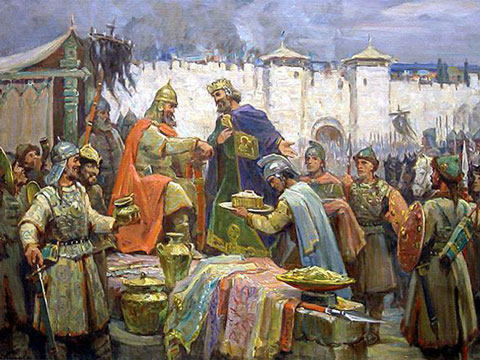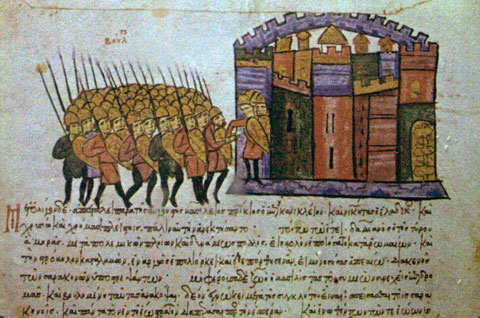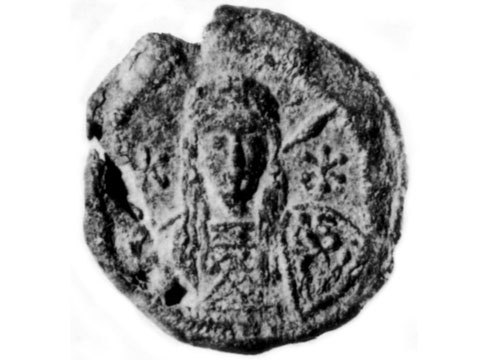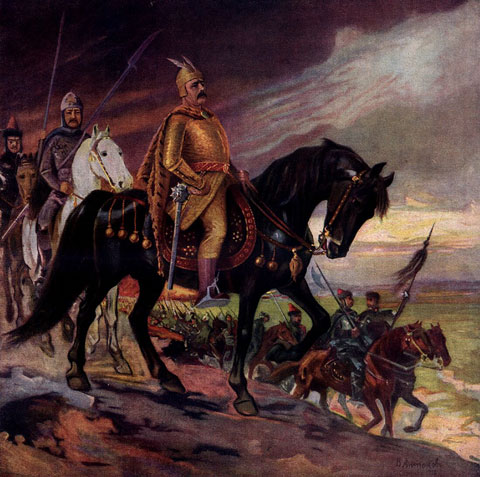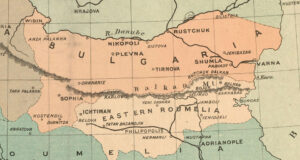Khan Tervel was the son of Asparukh and second ruler of the First Bulgarian Kingdom. His dates of birth, death and reign are unsure, and can only be approximated from extant sources.
Khan Tervel Background
The name list of Bulgarian Kings says Tervel was a member of the Dulo clan and reigned for 21 years. According to the list he ruled from 695- 715, but taking into consideration the historical events in which he played a part, it is likely that he ruled slightly later, from about 700-721.
 Tervel was probably a Christian like his grandfather. In 1972 a medieval lead seal was discovered carrying the Greek inscription “Mother of God, help Caesar Tervel.”
Tervel was probably a Christian like his grandfather. In 1972 a medieval lead seal was discovered carrying the Greek inscription “Mother of God, help Caesar Tervel.”
As ruler of Bulgaria, Khan Tervel defended his nation against aggressors, expanded its borders southward into northeastern Thrace, and earned the moniker “Saviour of Europe” for helping Constantinople hold off an Arab siege.
He is recognized as a Saint in the Bulgarian Orthodox Church. His feast day is celebrated on 4 January and 3 September.
Khan Tervel Backs Justinian II in Battle for the Throne
The earliest mentions of Khan Tervel surround the plight of Byzantine Emperor Justinian II during the years 704-705. When Justinian was deposed by rivals, he escaped to Bulgaria looking for help. Tervel responded by dispatching an army of 15,000 cavalry to accompany Justinian in a quest to recapture his throne. Upon successful restoration, Justinian rewarded Tervel with gifts of gold, silver and silk, by handing over to the Bulgarians the Zagoria region of northeastern Thrace, and by promising Tervel the hand of his daughter Anastasia in marriage. Also, in a unique act of respect, he bestowed on Tervel the title Caesar, making him second in rank in the Byzantine Empire, the only time such honor was given to a foreigner.
Byzantine Attack and the Demise of Justinian II
Three years later, in 708, Justinian II reneged on the territorial concession and launched an attack against the Bulgarians to take it back. The Byzantine army assembled near the Fortress of Anchialus, at present day Pomorie, to prepare for battle. They were surprised by the Bulgarians and routed in the Battle of Anchialus, with most of the Byzantine soldiers killed or captured. The Emperor managed to escape by ship and return to Constantinople.
In 711, hard pressed by a rebellion against his rule, Justinian again sought help from Bulgaria. This time Tervel sent him only 3000 men. Justinian was captured by his enemies outside Constantinople and beheaded. The new Emperor allowed Tervel’s troops to return home.
A New Treaty and the Siege of Constantinople
After the death of Justinian, Tervel took advantage of Byzantine confusion to plunder Thrace. In 712 he advanced all the way to the walls of Constantinople, only to withdraw after extorting treasure from the citizens there. Tervel’s ability to pillage Thrace with impunity eventually forced the Byzantines to sue for peace.
In 716 Tervel entered into a new peace treaty with the Byzantine Empire. The new treaty confirmed the previous land grant in northeastern Thrace, specified the borders between the Bulgarian kingdom and the Byzantine Empire in greater detail, reconfirmed the payment of tribute from the Byzantine Empire to Bulgaria, agreed to an exchange of refugees, and defined trade policy between the states.
This treaty was a diplomatic victory for Tervel. The annual tribute was to be paid in valuable and prestigious goods. The new borders extended Bulgarian hegemony farther south, gave Bulgaria control over important trade routes, and secured Bulgarian access to the southern Black Sea ports. The trade provisions gave the Bulgarians unprecedented access to eastern markets and control over the shipping of goods.
In 717, Constantinople was attacked by a large Arab force. Besieged by both land and sea, the Emperor turned again to Bulgaria for help. The Bulgarians took up positions behind the Arabs in the fall of 717, attacking them from the rear. Their first major battle resulted in a decisive victory for the Bulgarians, leaving the Arabs trapped between them and the walls of the city, forced to defend themselves on two sides. Weakened by long months of fighting, winter weather, and disease, the Arabs eventually attempted a retreat, but the Bulgarians crushed their land forces before they could escape, killed over 20,000 Arab troops.
The Bulgarian rescue of Constantinople effectively halted the Arab advance in the east. It would be five centuries before another powerful force would be able to mount a serious attack against Byzantium from that direction.
Khan Tervel and the Madara Horseman
Historians have dated the monumental Madara Horseman relief carving to about 710, during the reign of Khan Tervel. The relief depicts a mounted horseman stabbing a spear into a lion at his feet, with an eagle flying above and a dog trotting along behind the horse and rider. The oldest inscription accompanying the relief seems to describe Tervel’s victorious fight on behalf of Justinian II in 705. The Madara Horseman was entered into the UNESCO World Heritage list in 1979.
View more images of the First Bulgarian Kingdom:


